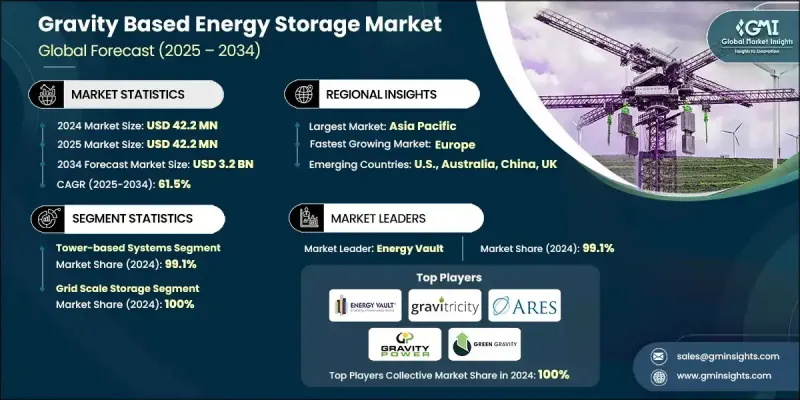PUBLISHER: Global Market Insights Inc. | PRODUCT CODE: 1858826

PUBLISHER: Global Market Insights Inc. | PRODUCT CODE: 1858826
Gravity Based Energy Storage Market Opportunity, Growth Drivers, Industry Trend Analysis, and Forecast 2025 - 2034
The Global Gravity Based Energy Storage Market was valued at USD 42.2 million in 2024 and is estimated to grow at a CAGR of 61.5% to reach USD 3.2 billion by 2034.

This surge is fueled by the urgent global demand for sustainable, long-duration storage solutions that support renewable integration, grid resilience, and decarbonization goals. Gravity-based systems, unlike conventional chemical batteries, offer long operational lifespans, minimal degradation, and environmental compatibility, making them a vital enabler of the clean energy transition. With governments worldwide imposing stricter net-zero mandates, utilities and developers are increasingly turning to gravity storage as a complement to lithium-ion systems. These systems harness simple yet effective physics, lifting and lowering heavy weights to deliver reliable, scalable, and cost-effective energy storage. Their ability to repurpose abandoned mines, rail systems, or industrial sites for deployment further enhances their sustainability profile, aligning with circular economy principles and global decarbonization strategies.
| Market Scope | |
|---|---|
| Start Year | 2024 |
| Forecast Year | 2025-2034 |
| Start Value | $42.2 Million |
| Forecast Value | $3.2 Billion |
| CAGR | 61.5% |
The tower-based systems segment held a 99.1% share in 2024. Tower-based systems are gaining momentum due to their modular scalability, straightforward engineering, and proven ability to provide multi-hour discharge cycles with low maintenance requirements. These solutions are attractive for utility-scale projects, where they offer predictable performance, long service life, and reduced operational risks compared to chemical storage. Underground systems are also emerging as a competitive alternative, leveraging decommissioned mines and vertical shafts for energy storage, providing high density and low visual impact.
The renewable integration segment is expected to reach USD 1.5 billion by 2034. Their scalability makes them particularly suitable for hybrid energy projects, pairing seamlessly with solar farms, offshore wind installations, and community-scale renewable microgrids. Grid-scale storage, while slightly smaller in 2024, is projected to grow rapidly as utilities adopt gravity systems for load balancing, black-start capabilities, and ancillary services such as frequency and voltage regulation. This dual role supporting both renewables and grid infrastructure cements gravity storage as a central pillar of the future energy landscape.
China Gravity-Based Energy Storage Market will reach USD 964.3 million by 2034. China's government-backed initiatives, including storage mandates tied to renewable deployment, have accelerated the commercialization of large-scale gravity projects. Australia, on the other hand, has pioneered the adaptive reuse of legacy mining infrastructure, cutting capital costs while creating environmentally sustainable solutions.
Key players in the Global Gravity-Based Energy Storage Market include Energy Vault, Gravitricity, Green Gravity Energy, ARES North America, GRAVIENT, Gravity Power, Gravity Storage, and RheEnergise Limited. These companies are advancing commercialization through partnerships, pilot projects, and innovative engineering approaches. Energy Vault, for instance, has achieved dominance with a 99.1% share of installed capacity in 2024, while firms like Gravitricity and Green Gravity are leveraging unique applications such as mine-shaft repurposing and compressed-earth block technologies. Collectively, these innovators are shaping a dynamic, competitive landscape that blends sustainability with large-scale energy resilience.
Table of Contents
Chapter 1 Methodology & Scope
- 1.1 Research design
- 1.2 Market estimates & forecast parameters
- 1.3 Forecast calculation
- 1.4 Data sources
- 1.4.1 Primary
- 1.4.2 Secondary
- 1.4.2.1 Paid
- 1.4.2.2 Public
- 1.5 Market definitions
Chapter 2 Executive Summary
- 2.1 Industry synopsis, 2021 - 2034
Chapter 3 Industry Insights
- 3.1 Industry ecosystem analysis
- 3.2 Price trend analysis, 2021 - 2034
- 3.2.1 By region
- 3.3 Regulatory landscape
- 3.4 Industry impact forces
- 3.4.1 Growth drivers
- 3.4.2 Industry pitfalls & challenges
- 3.5 Growth potential analysis
- 3.6 Porter's analysis
- 3.6.1 Bargaining power of suppliers
- 3.6.2 Bargaining power of buyers
- 3.6.3 Threat of new entrants
- 3.6.4 Threat of substitutes
- 3.7 PESTEL analysis
- 3.7.1 Political factors
- 3.7.2 Economic factors
- 3.7.3 Social factors
- 3.7.4 Technological factors
- 3.7.5 Legal factors
- 3.7.6 Environmental factors
Chapter 4 Competitive Landscape, 2025
- 4.1 Introduction
- 4.2 Company market share analysis, 2024
- 4.3 Strategic dashboard
- 4.4 Strategic initiatives
- 4.4.1 Key partnerships & collaborations
- 4.4.2 Major M&A activities
- 4.4.3 Product innovations & launches
- 4.4.4 Market expansion strategies
- 4.5 Competitive benchmarking
- 4.6 Innovation & sustainability landscape
Chapter 5 Market Size and Forecast, By Technology, 2021 - 2034 (USD Million & MW)
- 5.1 Key trends
- 5.2 Tower-based systems
- 5.3 Underground systems
- 5.4 Others
Chapter 6 Market Size and Forecast, By Application, 2021 - 2034 (USD Million & MW)
- 6.1 Key trends
- 6.2 Grid scale storage
- 6.3 Renewable integration
Chapter 7 Market Size and Forecast, By Region, 2021 - 2034 (USD Million & MW)
- 7.1 Key trends
- 7.2 North America
- 7.2.1 U.S.
- 7.2.2 Canada
- 7.3 Europe
- 7.3.1 Germany
- 7.3.2 UK
- 7.3.3 Finland
- 7.4 Asia Pacific
- 7.4.1 China
- 7.4.2 Australia
- 7.5 Rest of World
Chapter 8 Company Profiles
- 8.1 ARES North America
- 8.2 Energy Vault
- 8.3 GRAVIENT
- 8.4 Gravitricity
- 8.5 Gravity Power
- 8.6 Gravity Storage
- 8.7 Green Gravity Energy Pty
- 8.8 Renewell Energy
- 8.9 RheEnergise Limited
- 8.10 Terrament




